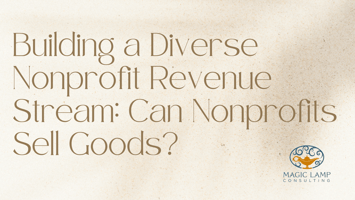Grant Dependency: How to Wean Your Nonprofit Off a Single Source of Funding

Grants are often a crucial source of funding for nonprofits, allowing organizations to pursue their mission, launch new programs, and expand their impact. However, relying too heavily on grants—especially a single source—can put nonprofits in a challenging financial position. When grants become the lifeblood of an organization, the loss or reduction of funding can have severe consequences, disrupting services and even threatening the organization’s existence.
While grants will likely always play an important role in nonprofit funding, it’s essential to diversify revenue streams to reduce vulnerability and ensure long-term sustainability. In this blog post, the Magic Lamp Consulting team will explore why grant dependency is risky and provide strategies for nonprofits to wean themselves off a single source of funding by building more diversified and sustainable revenue streams.
The Risks of Grant Dependency
Nonprofits that rely too heavily on grants face several challenges. For one, grant funding is often unpredictable. Grants can be renewed or withdrawn based on shifting priorities from funders, changes in the economy, or the organization's ability to meet specific grant criteria. A sudden loss of grant funding can lead to program cuts, layoffs, or even the closure of the organization.
Moreover, many grants come with restrictions, dictating how the funds must be spent. This can limit a nonprofit's flexibility, preventing it from addressing urgent needs or investing in organizational growth. Over time, a heavy reliance on grants can stifle innovation, as organizations may focus more on meeting funder requirements than on evolving their services or exploring new opportunities.
In short, grant dependency can leave nonprofits financially fragile, with little control over their future. To avoid this, nonprofits need to take proactive steps to diversify their income sources.
Diversifying Revenue: A Path to Sustainability
Building a sustainable funding model requires nonprofits to move beyond a sole reliance on grants and cultivate a variety of revenue streams. Here are several strategies nonprofits can implement to reduce their dependency on grants:
1. Strengthen Individual Giving Programs
Individual donors are often the backbone of nonprofit support, providing a steady and reliable source of revenue. By focusing on growing individual donations, nonprofits can create a more sustainable funding base. Some key tactics include:
- Donor engagement: Building strong, long-term relationships with donors is critical. Nonprofits should regularly communicate with their donors, showing them the impact of their contributions and thanking them for their support. Personalized outreach can help increase donor retention and encourage repeat giving.
- Monthly giving programs: Offering donors the option to give recurring, smaller donations on a monthly basis can provide a consistent revenue stream. Monthly giving programs are also convenient for donors and can help build stronger connections with the organization.
- Peer-to-peer fundraising: Leveraging your supporters to fundraise on your behalf can expand your donor base. Through peer-to-peer fundraising, supporters can share your mission with their networks, introducing new potential donors to your cause.
2. Develop Corporate Partnerships
Corporate partnerships offer another significant opportunity for nonprofits to diversify their funding. Many businesses are eager to partner with nonprofits that align with their values, as it provides a way for them to give back to the community while enhancing their corporate social responsibility (CSR) efforts.
To attract corporate support, nonprofits should consider:
- Sponsorships: Companies may sponsor events, programs, or campaigns in exchange for visibility and recognition within the nonprofit's community. This can be a win-win, offering businesses a way to promote their brand while supporting a cause.
- Workplace giving: Some corporations offer matching gift programs where they match their employees' donations to nonprofits. Establishing relationships with companies that encourage workplace giving can increase individual donations and broaden your reach.
3. Offer Fee-for-Service Programs
Charging fees for certain programs or services is a practical way for nonprofits to generate income while furthering their mission. Fee-for-service models allow organizations to provide value to the community while becoming less reliant on outside funding.
Examples of fee-for-service activities include:
- Offering educational workshops or training programs that align with your mission.
- Charging for access to specialized resources or tools that your nonprofit develops.
- Partnering with local governments or businesses to deliver services on a contract basis.
By offering services that fill a need in your community, nonprofits can create an additional stream of revenue without compromising their values.
4. Launch Social Enterprises
Social enterprises are mission-driven businesses that generate income for a nonprofit while addressing social, environmental, or economic challenges. These ventures can provide a sustainable revenue source while furthering the organization’s mission.
Examples of social enterprises include:
- Selling products or merchandise that align with your nonprofit’s mission, such as fair-trade goods or environmentally friendly items.
- Providing services to the public or other organizations that can be monetized, such as consulting, event planning, or professional services.
Social enterprises are a creative way to generate unrestricted funds that can be reinvested into the organization, offering both financial security and greater mission impact.
Our Conclusion
While grants are an important and often necessary component of nonprofit funding, relying too heavily on them can be risky. Nonprofits that diversify their revenue sources—through individual donations, corporate partnerships, fee-for-service programs, and social enterprises—build financial resilience and ensure they can sustain their mission even when grant funding is reduced or unavailable.
By proactively working to reduce grant dependency and developing sustainable funding streams, nonprofits can achieve greater stability, flexibility, and impact. This shift not only strengthens the organization but also secures its ability to serve the community for years to come.




